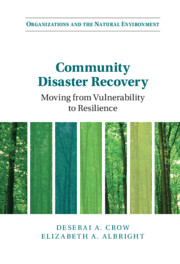Book contents
- Community Disaster Recovery
- Organizations and the Natural Environment
- Community Disaster Recovery
- Copyright page
- Dedication
- Contents
- Figures
- Tables
- About the Authors
- Foreword
- Preface
- Acknowledgments
- Abbreviations
- Part I Introduction
- 1 Introduction to Disasters, Change, and Community-Level Resilience
- 2 Colorado’s 2013 Floods
- Part II Damage and Resources
- Part II Review
- Part III Individual Beliefs
- Part III Review
- Part IV Individual and Group Engagement
- Part IV Review
- Part V Connections, Conclusions, and Recommendations
- Book part
- Bibliography
- Index
2 - Colorado’s 2013 Floods
The Disaster That Primed Community-Level Learning
from Part I - Introduction
Published online by Cambridge University Press: 08 October 2021
- Community Disaster Recovery
- Organizations and the Natural Environment
- Community Disaster Recovery
- Copyright page
- Dedication
- Contents
- Figures
- Tables
- About the Authors
- Foreword
- Preface
- Acknowledgments
- Abbreviations
- Part I Introduction
- 1 Introduction to Disasters, Change, and Community-Level Resilience
- 2 Colorado’s 2013 Floods
- Part II Damage and Resources
- Part II Review
- Part III Individual Beliefs
- Part III Review
- Part IV Individual and Group Engagement
- Part IV Review
- Part V Connections, Conclusions, and Recommendations
- Book part
- Bibliography
- Index
Summary
Chapter 2 of Community Disaster Recovery: Moving from Vulnerability to Resilience examines the case of Colorado’s extreme floods of 2013, describing the event, damages, and the aftermath during the early weeks of disaster recovery.It sets the stage for subsequent chapters that empirically assess the disaster recovery processes and outcomes. The extreme flooding that occurred in Colorado in 2013 began with heavy rain from a stationary front, with the worst coming on September 11 and 12. The rivers along Colorado’s Front Range swelled from the storm beginning September 9. Flash flooding soon occurred in the narrow mountain canyons and communities, overwhelming communities nestled at the mouths of canyons. This floodwater then slowly moved east to the agricultural communities in the plains including Evans. Seventeen Colorado counties across nearly 200 miles (north to south) were affected by the flood event, for a total of 4,500 square miles.
- Type
- Chapter
- Information
- Community Disaster RecoveryMoving from Vulnerability to Resilience, pp. 27 - 46Publisher: Cambridge University PressPrint publication year: 2021



